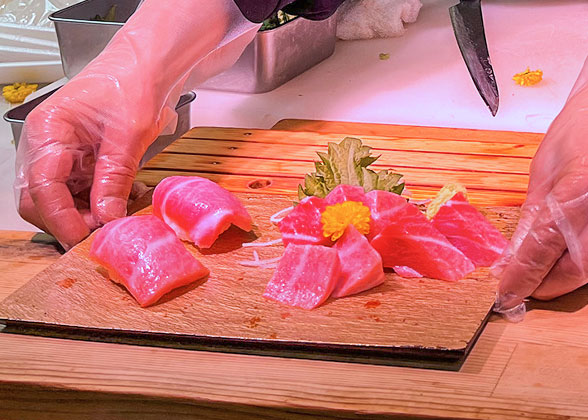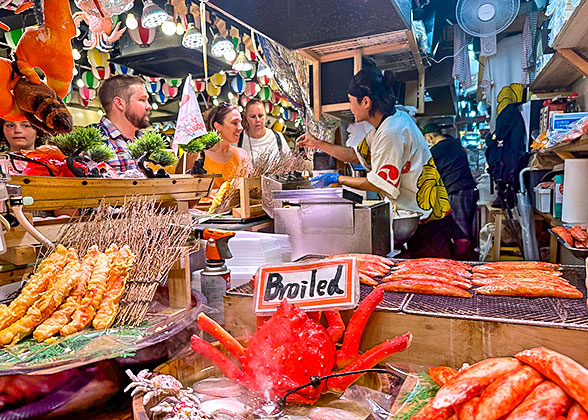What Food Is Uniquely Japanese
Referring unique Japanese food, you may think of sushi, sashimi, etc. Actually, most Japanese food have a quite unique flavor, especially washoku – the traditional ones. Here are the most unique food in Japan, and even some may be wired for non-Japanese.1. Funazushi – Fermented Fish Sushi
As everyone knows, sushi is definitely a food uniquely Japanese. Nigiri-sushi is the most common, which is formed with hands, with raw fish slice on the rice ball. Funazushi might be the oldest type of sushi, popular around Lake Biwa east to Kyoto, and was an article of tribute to the emperor. In spring, the oviferous carps in Lake Biwa were caught and salted for months; to summer, the salted carps were pickled and fermented for 1-2 years. The fermented fish sushi is usually sliced, going with tea or sake. It is sour and sweet like animal cheese, but many people can’t stand its frowzy acid smell. Would you like it?2. Basashi & Torisashi – Sashimi of Horsemeat & Chicken

Freshly-Made Sashimi
|
3. Ochazuke – Rice in Tea
You won’t be strange to both rice and tea. However, have you tried to soak rice in a cup of tea? Japanese have done for over a thousand years. They put some needle-like nori pieces, cooked sesames and chopped green onion on the top of rice, and add the seasonings according to their preference. Salt, Japanese soy sauce, wasabi, etc. are the common seasonings they use. After that, the freshly brewed tea is poured into the bowl over the side, making the half or two-thirds of rice is immersed. Nowadays, there are a great variety of ochazuke in Japan, varied in tea, rice, toppings and seasonings.4. Wagashi – Japanese Traditional Refreshments

Matcha Wagashi
|
5. Natto – Smelly Fermented Beans
It’s a national food hard to tell in Japan. For its high level of protein and antimicrobial substance, natto was popularized. It’s a little sweet and sticky, but it emits a strong smell as being fermented. Some people, even some Japanese, think that the smell is foul. As being stirred, you will see a white sticky substance attached to the beans. Anyway, it has been a common food for every family. Most simply, Japanese will stir the rice with natto, raw egg liquid and chopped green onion. Besides, they would add it to fried dishes, curry, tofu, wasabi, pickles, kelp, the stuffing of gyoza, udon noodles, sushi, and everything you can image.6. Fugu - Puffer Fish
Japanese love fugu, puffer fish in Japanese, as a food very much. Yeah, the puffer fish you may know, it is poisonous. In Japanese culture, this is a toothsome and nutritious food, as well as a fish of good fortune. For the safety to eat fugu, chefs must go through strict training and obtain the nationally recognized license. In this way, it’s ensured that the puffer fish is clear with poisonous parts removed. Sashimi is the most popular way to eat fugu. The thin slices of puffer fish is crystal clear, which is breathtakingly seductive as lined ingeniously on the plate. Shabushabu of fugu, fugu soup with shredded white radish, deep-fried fugu, grilled fugu, etc. are also sought-after. As it is dangerous, please choose a reputable restaurant of puffer fish if you want to try.

Raw Egg Served with Rice
|
7. Nama Tamago - Raw Egg
Egg is one of the favorite food around the world, but Japanese like raw eggs, what they call nama tamago. They stir the rice with raw egg and more seasonings like chopped nori, which is added to neutralize the smell of eggs. They would also beat an egg into the udon noodles, and mix well when eating. Curry with raw egg liquid is also welcomed, while it is nice to crack an egg on ice cream, too. As for yakiniku (Japanese grilling) and shabushabu, they often add a raw egg into the dipping sauce... In brief, Japanese like to mix the raw egg into almost all things to eat. You’d better not to try if you're not used to the taste.8. Shirako – Milt of Male Fishes
Believe it or not, shirako is a traditional food in Japan, and many people like it; despite it is controversial about whether people should eat it or not. The milt of male fishes is rich in protein, looked like a lump of milky white balls. It’s said to be umami and somewhat sweet, widely seen in some crucial occasions and festival events as a high-end food around the country. It’s cumbersome to extract the milt of fishes, so it’s quite expensive. The most common shirako is extracted from cods and anchovies, which makes winter and spring the high season of this food. The milts are grilled, steamed, or boiled in Japan, and gone with soy sauce, lemon juice, or other more seasonings.Read More:
You May Like
-
 10 Days Private Japan Tour of Honshu, to Tokyo, Mt. Fuji, Shirakawa-go, Kyoto, Hiroshima... from USD3809
10 Days Private Japan Tour of Honshu, to Tokyo, Mt. Fuji, Shirakawa-go, Kyoto, Hiroshima... from USD3809 -
 7 Days Mini Group Tour with Essence of Japan: Tokyo - Mt. Fuji - Kyoto - Nara - Osaka from USD2155
7 Days Mini Group Tour with Essence of Japan: Tokyo - Mt. Fuji - Kyoto - Nara - Osaka from USD2155 -
 11 Days Mini Group Tour to Tokyo - Hakone (Mt. Fuji) - Kyoto - Nara - Osaka - Hiroshima... from USD3554
11 Days Mini Group Tour to Tokyo - Hakone (Mt. Fuji) - Kyoto - Nara - Osaka - Hiroshima... from USD3554

